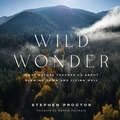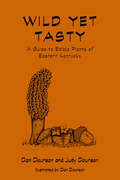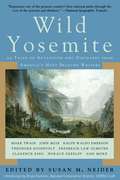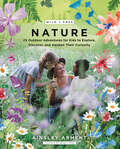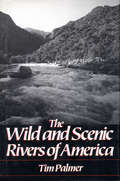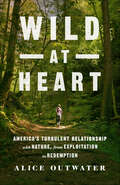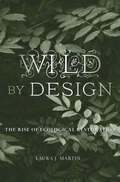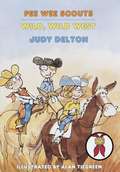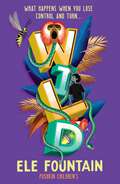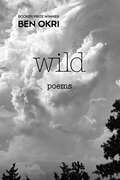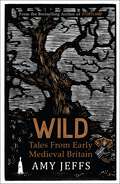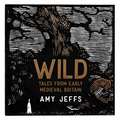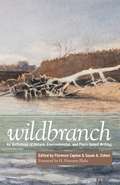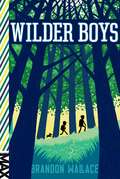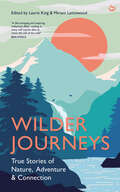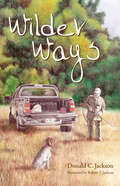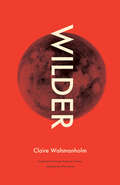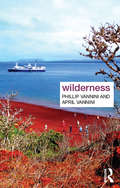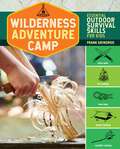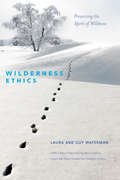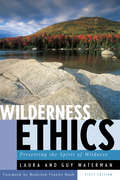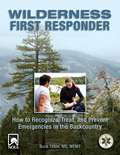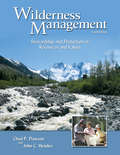- Table View
- List View
Wild Wonder: What Nature Teaches Us About Slowing Down and Living Well
by Stephen ProctorAn invitation to explore the life-giving lessons we can learn from the Earth, featuring stunning photography and reflections from an acclaimed visual artistThe Earth is the first tangible gift we were given. Yet when did you last pause to appreciate the immensity of the ocean, wander in silence through an ancient forest, or behold the grandeur of a mountain? How long has it been since you&’ve felt grass beneath your feet?Accompanied by awe-inspiring full-color photography from landscape cinematographer and visual artist Stephen Proctor, Wild Wonder: What Nature Teaches Us About Slowing Down and Living Well combines pastoral observations about creation with an exploration of how it can provide healing to our minds and bodies. Divided into five parts that are each devoted to a unique aspect of nature—oceans, forests, rivers, ice, and mountains—Proctor encourages readers to recognize how being outside restores us and offers us a renewed sense of awe and wonder for the Creator.In each of the thirty brief essays, he points to some of the deep lessons nature can teach us. We can appreciate the gift of silence while observing a glacier, gain a new perspective on top of a mountain, learn the skill of slowing down from a river, and experience a metaphor of redemptive life after death through nurse logs. Each part includes an interview from an artist whose inspiration has been drawn from nature and ends with a &“Time to Fly!&” section that features reflection questions, simple action prompts, and sources for further exploration.Whether outdoor enthusiasts or armchair adventurers, readers of this book will be drawn into a more holistic and contemplative way of life and a deeper awareness of the beautiful world around them.
Wild Yet Tasty: A Guide to Edible Plants of Eastern Kentucky
by Dan Dourson Judy DoursonDiscover eastern Kentucky&’s edible plants and learn how to identify them, what parts to eat, best harvest times and more, in this handy forager&’s guide. Eastern Kentucky is home to a number of breathtaking natural attractions. Over half a million visitors each year are drawn to its scenic beauty, abundant hiking trails, and exceptional rock climbing. The region also holds some of the most diverse ecosystems in the world, from forest and mountain terrain to caves and ravines. This dramatic mixture of microclimates creates a natural abundance, including numerous edible plants, not found elsewhere in the region. Many are unfamiliar with these fascinating florae species, but Wild Yet Tasty by Dan Dourson and Judy Dourson provides a wealth of information about these comestible, natural treasures. This compact guide provides a useful introduction to the most commonly found and easily identified species, ranging from well-known edibles like morels, blackberries, and persimmons to ones that are not as commonly eaten, such as toothwort, common greenbrier, and redbud. Included are detailed line drawings and descriptions to help with identification, habitat information, specifics on what parts are eatable, and suggestions for the best time to harvest. A glossary of terms and tips for preparing wild food make this guide an invaluable resource for hikers, climbers, and campers visiting the region.Praise for Wild Yet Tasty &“A slim volume that is easy to take with you on a hike or a stroll through the woods of eastern Kentucky. . . . A useful and enjoyable guide.&” —The Council on Botanical and Horticultural Libraries &“A compact treasure as it is sufficiently descriptive without being oppressively technical.&” —Journal of the Botanical Research Institute of Texas
Wild Yosemite: 25 Tales of Adventure and Discovery from America's Most Beloved Writers
by Susan M. NeiderAn ideal gift for lovers of nature. This beautiful literary collection explores the spectacular natural features of Yosemite through the eyes of some of America’s most notable and extraordinarily talented writers. In 1851, Lafayette Bunnell chronicled his travels with the Mariposa Battalion, the first non-natives to visit Yosemite Valley. Following in his footsteps, Theodore Roosevelt, Ralph Waldo Emerson, Mark Twain, Clarence King, Frederick Law Olmsted, Joaquin Miller, and Horace Greeley made their pilgrimages and were moved to recount their observations. Included here as well is the work of John Muir, founder of the Sierra Club, whose love for Yosemite led to the establishment of Yosemite National Park in 1890. This lyrical book is a literary tribute to Yosemite’s gorgeous landscape. A great companion for those who love to travel and revel in the unique natural beauty of the great American West, Wild Yosemite will transport you in spirit to the heart of the Sierra Nevadas, where you’ll experience the canyons, the cliffs, the pines, the mountain air, and the panoramic grandeur of Yosemite National Park.
Wild and Free Nature: 25 Outdoor Adventures for Kids to Explore, Discover, and Awaken Their Curiosity (Wild and Free)
by Ainsley ArmentThe companion to The Call of the Wild + Free: styled in the lush aesthetic of the Wild + Free brand, a four-color book offering outdoor activities and essays, that parents, educators, and caregivers can use to inspire their children.Wild and Free Nature is a beautiful, four-color resource book for parents, educators, and caregivers to enjoy doing hands-on activities outside with kids. One of the core philosophies behind Wild + Free is the belief that nature is the best classroom we could ever hope for. It unlocks the imagination and inspires creativity in ways that a schoolroom never could.Being out in nature has a number of benefits. Studies show that children are more likely to interact with kids of different ages and learn to problem solve in natural settings. Being in natural settings stimulates the brain and restores cognitive function. Children who spend time in natural settings also interact better with kids of all ages and learn to solve problems more easily. They build muscle and coordination and fend off obesity. It cultivates a sense of responsibility for caring for the earth, not to mention, encourages imaginative play, curiosity, and other qualities necessary to spark a love for investigation and learning.This resource book will help equip parents and adults who work with children to get them outdoors with activities such as:Build a treehouse in the woods.Cultivate a garden plot.Make land art and nature crafts.Create a mud kitchen in the backyard.Go for a nature walk each morning.Find a secret swimming hole.Go to the creek to learn about the water cycle.Plant a garden to see what will grow in your backyard.Raise monarch caterpillars and feed them milkweed until they transform into butterflies.Set up a birdwatching station in your front window equipped with binoculars, notebooks, and bird guides.Make a wilderness fort with the fallen branches from trees. With the same lush photography as The Call of the Wild + Free, this book includes step-by-step pictures that show parents how to do the activity, and essays on the importance of nature in a child's life.
Wild and Scenic Rivers of America
by Tim PalmerThe National Wild and Scenic Rivers Act is one of the most important natural areas protection programs ever established at the federal level. It has resulted in the creation of the National Wild and Scenic Rivers System -- a rich American legacy that includes many of our finest waterways. This book is the definitive resource on the National Wild and Scenic Rivers System. Topics covered include: the importance of protecting river ecosystems state and local protection systems the history of the National Wild and Scenic Rivers System descriptions of each of the major rivers in the system how and why rivers are chosen for inclusion river management continuing threats to rivers what can be done to make the system more effective and more inclusive
Wild at Heart: America's Turbulent Relationship with Nature, from Exploitation to Redemption
by Alice Outwater"Alice Outwater’s infectiously readable Wild at Heart captures the essence of ecology: Everything is connected, and every connection leads to ourselves." —Alan Weisman, author, The World Without Us and Countdown"A wonderful book. Information rich to say the least, and the indigenous human connections and portrait of the deep connectivity of nature, are both strong elements." —Jim McClintock, author of A Naturalist Goes FishingNature on the brink? Maybe not. With so much bad news in the world, we forget how much environmental progress has been made. In a narrative that reaches from Native American tribal practices to public health and commercial hunting, Wild at Heart shows how western attitudes towards nature have changed dramatically in the last five hundred years.The Chinook gave thanks for King Salmon's gifts. The Puritans saw Nature as a frightening wilderness, full of "uncooked meat." With the industrial revolution, nature was despoiled and simultaneously celebrated as a source of the sublime. With little forethought and great greed, Americans killed the last passenger pigeon, wiped out the old growth forests, and dumped so much oil in the rivers that they burst into flame. But in the span of a few decades, our relationship with nature has evolved to a more sophisticated sense of interdependence that brings us full circle. Across the US, people are taking individual action, planting native species and fighting for projects like dam removal and wolf restoration. Cities are embracing nature, too.Humans can learn from the past, and our choices today will determine whether nature survives. Like the First Nations, all nations must come to deep agreement that nature needs protection. This compelling book reveals both how we got here and our own and nature's astonishing ability to mutually regenerate.
Wild by Design: The Rise of Ecological Restoration
by Laura J. MartinAn environmental historian delves into the history, science, and philosophy of a paradoxical pursuit: the century-old quest to design natural places and create wild species. Environmental restoration is a global pursuit and a major political concern. Governments, nonprofits, private corporations, and other institutions spend billions of dollars each year to remove invasive species, build wetlands, and reintroduce species driven from their habitats. But restoration has not always been so intensively practiced. It began as the pastime of a few wildflower enthusiasts and the first practitioners of the new scientific discipline of ecology. Restoration has been a touchstone of US environmentalism since the beginning of the twentieth century. Diverging from popular ideas about preservation, which romanticized nature as an Eden to be left untouched by human hands, and conservation, the managed use of natural resources, restoration emerged as a “third way.” Restorationists grappled with the deepest puzzles of human care for life on earth: How to intervene in nature for nature’s own sake? What are the natural baselines that humans should aim to restore? Is it possible to design nature without destroying wildness? Laura J. Martin shows how, over time, amateur and professional ecologists, interest groups, and government agencies coalesced around a mode of environmental management that sought to respect the world-making, and even the decision-making, of other species. At the same time, restoration science reshaped material environments in ways that powerfully influenced what we understand the wild to be. In Wild by Design, restoration’s past provides vital knowledge for climate change policy. But Martin also offers something more—a meditation on what it means to be wild and a call for ecological restoration that is socially just.
Wild, Wild West (Pee Wee Scouts #37)
by Judy DeltonYahoo! The Pee Wees are visiting the Lazy T Ranch, where they get to wear cowboy hats, learn how to throw a lasso, and go horseback riding. There's even a spooky ghost town to explore. The only down side is the big square dance scheduled for the end of the weekend. None of the girls wants Roger or Sonny for a partner. Molly has a plan to avoid dancing with them. Will it work? The Pee Wees goof around, do good deeds, take on projects and have fun and adventures. Find out all about what scouts do in the many Pee Wee Scout books you can get from Bookshare including: #1 Cookies and Crutches, #2 Camp Ghost-Away, #3 Lucky Dog Days, #4 Blue Skies, French Fries, #5 Grumpy Pumpkins, #6 Peanut-Butter Pilgrims, #7 A Pee Wee Christmas, #8 That Mushy Stuff, #9 Spring Sprouts, #10 The Pooped Troop, # 11 The Pee Wee Jubilee, #12 Bad, Bad, Bunnies, #13 Rosy Noses, Frozen Toes, #14 Sonny's Secret, #15 Sky Babies, #16 Trash Bash, #17 Pee Wees On Parade, #18 Lights, Action, Land-ho!, #19 Piles of Pets, #20 Fishy Wishes, #21 Pee Wees on Skis, #22 Greedy Groundhogs, #23 All Dads On Deck, #24 Tricks and Treats, #25 Pee Wees on First, #26 Super Duper Pee Wees, #27 Teeny Weeny Zucchinis, #28 Eggs With Legs, #29 Pee Wee Pool Party, #30 Bookworm Buddies, #31 Moans and Groans and Dinosaur Bones, #32 Stage Frightened, #33 Halloween Helpers, #34 Planet Pee Wee, #35 Pedal Power, #36 Computer /Clues, #38 Send In The Clowns, and #39 Molly For Mayor.
Wild: A gripping rainforest adventure from the multi award-winning author of Refugee 8 7
by Ele FountainA moving, page-turning novel about a family's grief and the crisis afflicting the rainforest, from the prize-winning author of Refugee 87Ever since Jack's dad died, he's had a heavy feeling inside. The pressure keeps building. Looking for release, he starts skiving school and hanging around with a group who like to cause trouble. It's easy to hide his new habits from his mum, an environmental anthropologist, because she's too busy with work and conservation trips to notice.As Jack spins further out of control, his mum eventually becomes concerned – and shocks him by suggesting a trip together.But this will be no relaxing holiday. Soon Jack finds himself on an expedition deep into the rainforest, far from anything he's ever known. He wanted an adventure – but has he plunged into real danger?
Wild: Poems
by Ben OkriA rich, joyful collection of poems on living and loving from the Booker Prize–winning author.Freedom is the most precious commodity in the world. In this powerful collection, the celebrated novelist, essayist, dramatist, and poet Ben Okri explores the beauty contained in each one of us—the freedom of our spirit, the child within. He recalls the death of his father, the sacrifices of his mother, the hidden river of Edinburgh, falling in love. He writes about Virgil and Mozambique, about ringing the bell for freedom, the dreams of Calliope and the full moon. He enters the fifth circle, sings of the roses of spring, and aligns the pyramids to the magic stars.This is a gorgeous, exciting collection for everyone who loves Ben Okri&’s vibrant style, and a perfect introduction to new readers of his poetry.
Wild: Tales from Early Medieval Britain
by Amy JeffsBy the bestselling author of Storyland.Sheer cliffs, salt spray, explosive sea spume, thunderous clouds, icy waves, whales with mountains on their backs, sleet, bitter winds, bleak, impenetrable marshes, howling wolves, forests, the unceasing cries of birds and the death grip of subterranean vaults that have never seen the sun: these are wild landscapes of a world almost familiar.In Wild, Amy Jeffs journeys - on foot and through medieval texts - from landscapes of desolation to hope, offering the reader an insight into a world at once distant and profoundly close to home. The seven chapters, entitled Earth, Ocean, Forest, Beast, Fen, Catastrophe, Paradise, open with fiction and close with reflection. They blend reflections of travels through fen, forest and cave, with retelling of medieval texts that offer rich depictions of the natural world. From the Old English elegies to the englynion and immrama of the Celtic world - stories that largely represent figures whose voices are not generally heard in the corpus of medieval literature: women, outcasts, animals.Illustrated with original wood engravings, evoking an atmospheric world of whales, wolves, caves, cuckoos and reeds, Wild: Tales From Early Medieval Britain will leave readers feeling 'westendream': delight in the wilderness.
Wild: Tales from Early Medieval Britain
by Amy JeffsFrom the bestselling author of Storyland: A New Mythology of Britain comes a book that will reconnect, engross and indulge readers in wild landscapes and pause to reflect on our current position and relationship with nature. This unique audiobook features 7 original songs - musical illustrations composed and performed by the author and her collaborators.Sheer cliffs, salt spray, explosive sea spume, thunderous clouds, icy waves, whales with mountains on their backs, sleet, bitter winds, bleak, impenetrable marshes, howling wolves, forests, the unceasing cries of birds and the death grip of subterranean vaults that have never seen the sun: these are wild landscapes of a world almost familiar. In Wild, Amy Jeffs journeys - on foot and through medieval texts - from landscapes of desolation to hope, offering the reader an insight into a world at once distant and profoundly close to home. The seven chapters, entitled Earth, Ocean, Forest, Beast, Fen, Catastrophe, Paradise, open with fiction and close with reflection. They blend reflections of travels through fen, forest and cave, with retelling of medieval texts that offer rich depictions of the natural world. From the Old English elegies to the englynion and immrama of the Celtic world - stories that largely represent figures whose voices are not generally heard in the corpus of medieval literature: women, outcasts, animals. All songs written by Amy Jeffs except for Colours, written by Robbie Haylett.1. All Alone (Hos) 2. The Seafarer 3. Sweeney 4. The Whale 5. Wulf 6. Colours 7. Island of BirdsArrangements by Robbie Haylett. Performances by Amy Jeffs, Robbie Haylett, Stephen Wilkinson, Christina Riedl, Will Rumney, Chris Keelty and Natalie Brice. (P) 2022 Quercus Editions Limited
Wildbranch: An Anthology Of Nature, Environmental, And Place-based Writing
by Susan A. Cohen Florence CaplowWildbranch: An Anthology of Nature, Environmental, and Place-based Writing is a powerful collection of mostly unpublished essays and poetry by both prominent American environmental writers and exciting new voices. The poetry and essays by more than fifty contributors offer the reader glimpses into places as diverse as a forest in West Africa, the moors of Ireland, the canyons of the Sonoran desert mountains, and the fields of New England, and they reflect the varied perspectives of field biologists, hunters, farmers, environmental educators, wilderness guides, academics, writers, and artists. The collection is an intimate portrait of the natural world drawn through the wisdom, ecological consciousness, and open hearts of these exceptional contributors. The Wildbranch Writing Workshop, cosponsored by Orion magazine and Sterling College, has encouraged thoughtful natural history, outdoor, and environmental writing for more than twenty years.
Wilder Boys (Wilder Boys)
by Brandon WallaceTwo brothers will need all their wilderness skills to survive when they set off into the woods of Wyoming in search of their absent father.Jake and Taylor Wilder have been taking care of themselves for a long time. Their father abandoned the family years ago, and their mother is too busy working and running interference between the boys and her boyfriend, Bull, to spend a lot of time with them. Thirteen-year-old Jake spends most of his time reading. He pours over his father's journal, which is full of wilderness facts and survival tips. Eleven-year-old Taylor likes to be outside playing with their dog, Cody, or joking around with the other kids in the neighborhood.But one night everything changes. The boys discover a dangerous secret that Bull is hiding.And the next day, they come home from school to find their mother unconscious in an ambulance. Knowing they are no longer safe and with nowhere else to go, the Wilder Boys head off in search of their father. They only have his old letters and journal to help them, but they have to make it.It's a long journey from the suburbs of Pittsburgh to the wilderness of Wyoming; can the Wilder Boys find their father before Bull catches up with them?
Wilder Journeys: True Stories of Nature, Adventure and Connection
by Laurie King & Miriam LancewoodEnvironmental writer Laurie King and internationally bestselling author Miriam Lancewood present a collection of narrative non-fiction stories and poems on the human connection with nature.Follow the call of the wild with these incredible true stories from an international group of nature lovers, nomads and adventurers.In these pages, you are invited to share the wisdom they gained on their wild journeys. You will walk across the Australian desert with American explorer Angela Maxwell; live with Hamza Yassin and a family of eagles in Scotland; survive for 10 years in an Australian forest with Gregory Smith; hunt in the wilderness with Miriam Lancewood in New Zealand; chart Karl Bushby's passage through the formidable Darien Gap; and set up a surf school for people of colour in California with David Malana.With beautiful illustrations, a foreword from explorer Belinda Kirk and contributions from leading poets, including David Whyte and Fatimah Asghar, this book will inspire you to get out of your comfort zone and connect to your wild, animal soul.
Wilder Ways
by Donald C. JacksonIn Wilder Ways, Donald C. Jackson takes readers on a journey into the deep and very personal connections that can develop between people and wild places while hunting, fishing, and rambling across landscapes. Fishing by lantern light late at night for bullhead catfish on a small stream, hunting wood ducks and squirrels on his farm in north Mississippi, bow hunting deer as twilight creeps across a small clearing, handlining crabs in the Pascagoula River estuary, hunting caribou in Alaska and elk in Colorado, searching for blind fish in Ozark caves, and fighting a storm on an Indonesian river: Jackson leads us into reflections of our own journeys and helps us to understand that we can be part of a wilder way, often very near to our homes. We walk with him through the tall grass, wet with early morning dew, light tackle in hand, down to a “ditch” under a Mississippi highway bridge and then discover that the “ditch” is really a very fine stream full of fish. We recapture the essence of hunting by stalking fox squirrels in a small patch of hardwoods. We stand beside him, listening to the whistle of wings as ducks pass overhead in the pre-dawn light and fog that surround a tiny, brushy pond hidden in the woods. We smell the salt air and feel the power of a redfish as it strips line from the fishing reel while the sunset turns marsh to gold. We walk alone under the starlight along an Alaskan river after an afternoon of grayling fishing. We fall in love again with tents, tractors, and old brown dogs. Through the shared journeys in Wilder Ways, we link with the rhythms of the earth, understanding that the wilds are not something separate from us. We are all somewhat wilder than perhaps we ever imagine.
Wilder: Poems
by Claire WahmanholmA prize-winning debut poetry collection touching on themes of nature, loss, and history. In Wilder—selected by Rick Barot as the winner of the 2018 Lindquist & Vennum Prize for Poetry—Claire Wahmanholm maps an alien but unnervingly familiar world as it accelerates into cataclysm. Here refugees listen to relaxation tapes that create an Arcadia out of tires and bleach. Here the alphabet spells out disaster and devours children. Here plate tectonics birth a misery rift, spinning loved ones away from each other across an uncaring sea. And here the cosmos—and Cosmos, as Carl Sagan&’s hopeful words are fissured by erasure—yawns wide.Wilder is grimly visceral but also darkly sly; it paints its world in shades of neon and rust, and its apocalypse in language that runs both sublime and matter-of-fact. &“Some of us didn&’t have lungs left,&” writes Wahmanholm. &“So when we lay beneath the loudspeaker sky—when we were told to pay attention to our breath—we had to improvise.&” The result is a debut collection that both beguiles and wounds, whose sky is &“black at noon, black in the afternoon.&”Praise for Wilder &“Full of wonder and bewilderment, cosmic vision and earthly pain.&” —Rick Barot &“A lyric and formally daring collection.&” —Poets & Writers &“Wahmanholm moves lyrically through an apocalyptic disaster in her stunning and disquieting debut. . . . Wahmanholm&’s poems are studies in devastation and stark representations of the accompanying shock.&” —Publishers Weekly &“Wahmanholm&’s careful curation of words and sounds cradle the reader. . . . The poems in Wilder are powerful and compelling, interested not only in confronting the rifts in our history and landscape, but connecting us to each other.&” —Arkansas International
Wilderness
by Roger Zelazny Gerald HausmanIn 1808 trapper John Colter ran and climbed 150 miles through what is now Yellowstone National Park to escape a hundred pursuing Blackfoot warriors. In 1823 hunter Hugh Glass, left for dead after a bear attack, crawled 100 miles from the Grand Valley to the Missouri River.
Wilderness (Key Ideas in Geography)
by Phillip Vannini April VanniniWilderness provides a multidisciplinary introduction into the diverse ways in which we make sense of wilderness: how we conceptualise it, experience it, interact with, and imagine it. Drawing upon key theorists, philosophers, and researchers who have contributed important knowledge to the topic, this title argues for a relational and process based notion of the term and understands it as a keystone for the examination of issues from conservation to more-than-human relations.? The text is organized around themed chapters discussing the concept of wilderness and its place in the social imagination, wilderness regulation and management, access, travel and tourism, representation in media and arts, and the use of wilderness for education, exploration, play, and therapy, as well as its parcelling out in parks, reserves, or remote "wastelands". The book maps out the historical transformation of the idea of wilderness, highlighting its intersections with notions of nature and wildness and teasing out the implications of these links for theoretical debate. It offers boxes that showcase important recent case studies ranging from the development of adventure travel and eco-tourism to the practice of trekking to the changing role of technology use in the wild. Summaries of key points, further readings, Internet-based resources, short videos, and discussion questions allow readers to grasp the importance of wilderness to wider social, cultural, political, economic, historical and everyday processes. Wilderness is designed for courses and modules on the subject at both postgraduate and undergraduate levels. The book will also assist professional geographers, sociologists, anthropologists, environmental and cultural studies scholars to engage with recent and important literature on this elusive concept.
Wilderness Adventure Camp: Essential Outdoor Survival Skills for Kids
by Frank GrindrodWhether in the rugged backcountry or a suburban backyard, kids can experience the sense of personal independence and self-confidence that come from outdoor proficiency, while also developing a deeper connection to and understanding of the natural world. With this skills-based book, kids learn essential safety and survival tips and bushcraft that they need to have a safe wilderness experience. Led by outdoor leader Frank Grindrod of Earthwork Programs, every turn of the page takes kids on another stage of the journey. They learn how to pack for the outdoors, navigate using a map and a compass, choose and set up a campsite, handle and use a knife properly, build a fire, tie different types of knots, make a lean-to out of sticks and leaves, and cook over an open fire. This guide teaches more than just outdoor know-how; it fosters appreciation for the natural world and pride in knowing how to use its resources as a tool for survival and adventure.
Wilderness Days (A Fesler-Lampert Minnesota Heritage Book)
by Sigurd F. OlsonIn the evocative words of one of America&’s best-loved nature writers, Wilderness Days brings together the essence of the magnificent wilderness with which he so deeply identifies. Sigurd F. Olson collects from his writings those moments that most vividly depict the turn of the seasons in the great woodlands and waters of the legendary Quetico–Superior region overlapping the Ontario–Minnesota border.
Wilderness Ethics: Preserving the Spirit of Wildness
by Laura Waterman Guy WatermanThe classic environmental call to action 2014 marks the 50th anniversary of the passing of the Wilderness Act—the landmark piece of legislation to set aside and protect pristine parts of the American landscape. This anniversary edition of Wilderness Ethics should help put the many issues surrounding wilderness in focus.
Wilderness Ethics: Preserving the Spirit of Wildness
by Laura Waterman Guy WatermanThe classic environmental call to action 2014 marks the 50th anniversary of the passing of the Wilderness Act--the landmark piece of legislation to set aside and protect pristine parts of the American landscape. This anniversary edition of Wilderness Ethics should help put the many issues surrounding wilderness in focus.
Wilderness First Responder: How to Recognize, Treat, and Prevent Emergencies in the Backcountry
by Buck TiltonWilderness First Responder is a comprehensive text for the recognition, treatment, and prevention of emergencies happening in the wild. It's essential reading for wilderness instructors, trip leaders, guides, search and rescue groups, and anyone who works or plays far from definitive medical care. This invaluable resource includes expert, step-by-step instructions, clear illustrations, and "Signs and Symptoms" sidebars designed to help you provide immediate - whenever you are more than an hour away from an ambulance or a hospital. You'll learn how to conduct a patient assessment, improvise when ideal materials are not handy, and decide whether or not to evacuate a patient. Learn how to assess and treat: Airway obstructions Cardiac arrest External and internal bleeding Shock Spine injuries Head injuries Chest injuries Abdominal injuries Fractures and dislocations Athletic injuries Soft-tissue injuries Cold-or heat-induced injuries.
Wilderness Management
by John C. Hendee Chad P. DawsonA new edition of this classic 30-year-old textbook.
